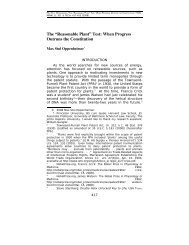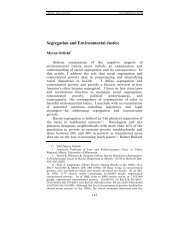An Organizational Approach to the Design of Patent Law
An Organizational Approach to the Design of Patent Law
An Organizational Approach to the Design of Patent Law
Create successful ePaper yourself
Turn your PDF publications into a flip-book with our unique Google optimized e-Paper software.
6 VERTINSKY FINAL_JAD (DO NOT DELETE) 2/27/2012 2:20 PM<br />
2012] AN ORGANIZATIONAL APPROACH 271<br />
law becomes a central part <strong>of</strong> international patent policy under<br />
this approach. Dreyfuss and Dinwoodie argue that <strong>the</strong> process<br />
<strong>of</strong> international intellectual property law should be <strong>the</strong> primary<br />
focus <strong>of</strong> attention, and that new administrative structures are<br />
needed <strong>to</strong> guide <strong>the</strong> development <strong>of</strong> international intellectual<br />
property law. Internationalization <strong>of</strong> intellectual property law<br />
is seen as occurring quickly through <strong>the</strong> activities <strong>of</strong> multiple<br />
participants and <strong>the</strong> impact <strong>of</strong> global trade and digital technologies.<br />
Dreyfuss and Dinwoodie call for <strong>the</strong> recalibration <strong>of</strong> <strong>the</strong><br />
balance between national and international norms through<br />
careful choice <strong>of</strong> institutional structures and ga<strong>the</strong>ring <strong>of</strong> information<br />
needed <strong>to</strong> make choices about international patent<br />
law fairly and consciously. 254 “Organizations such as <strong>the</strong> WTO<br />
and World Intellectual Property Organization (WIPO) evolve in<br />
response <strong>to</strong> <strong>the</strong> needs and interests <strong>of</strong> different stakeholders,<br />
with implications for both rule development and rule enforcement.”<br />
255<br />
E. PATENTS AND ENTREPRENEURSHIP<br />
The study <strong>of</strong> entrepreneurship and its determinants has<br />
been largely confined <strong>to</strong> disciplines o<strong>the</strong>r than law. A large and<br />
growing business literature supports <strong>the</strong> importance <strong>of</strong> entrepreneurship<br />
as a vehicle <strong>of</strong> economic progress and growth and<br />
explores <strong>the</strong> determinants <strong>of</strong> entrepreneurship and <strong>the</strong> variables<br />
that contribute <strong>to</strong> <strong>the</strong> success and failure <strong>of</strong> new ventures.<br />
But despite <strong>the</strong> importance <strong>of</strong> intangible assets in new business<br />
ventures and <strong>the</strong> role <strong>of</strong> ideas and control over <strong>the</strong>se ideas in<br />
fueling entrepreneurship, <strong>the</strong> relationship between patents and<br />
entrepreneurship has received little attention from patent<br />
scholars. 256 If we agree that entrepreneurs play an important<br />
Dinwoodie, The Integration <strong>of</strong> International and Domestic Intellectual Property<br />
<strong>Law</strong>making, 23 COLUM.-VLA J.L. & ARTS 307, 307–08 (2000).<br />
254. See Dinwoodie & Dreyfuss, TRIPS and <strong>the</strong> Dynamics <strong>of</strong> Intellectual<br />
Property <strong>Law</strong>making, supra note 240, at 95–97 (examining <strong>the</strong> extent <strong>to</strong> which<br />
TRIPs dispute resolution adequately accommodates <strong>the</strong> operation <strong>of</strong> each<br />
member’s political economy as it relates <strong>to</strong> intellectual property lawmaking).<br />
See generally Graeme B. Dinwoodie & Rochelle C. Dreyfuss, International Intellectual<br />
Property <strong>Law</strong> and <strong>the</strong> Public Domain <strong>of</strong> Science, 7 J. INT’L ECON. L.<br />
431 (2004) (examining <strong>the</strong> scope for domestic responses <strong>to</strong> public domain in<br />
<strong>the</strong> face <strong>of</strong> international legal frameworks governing patent law).<br />
255. See, e.g., Dinwoodie, supra note 248, at 207–10 (examining international<br />
norm creation by a wide range <strong>of</strong> institutions, both public and private,<br />
and <strong>the</strong> implications for <strong>the</strong> future development <strong>of</strong> <strong>the</strong> international IP system).<br />
256. See Stuart J.H. Graham & Ted M. Sichelman, Why Do Start-Ups Pa-






